Bus & Tram Journeys Multiple bus rides made in a one hour period count as a single bus journey.
Tube & train journeys.
Your fare is

JavaScript is disabled
Please enable JavaScript in your browser in order to use OysterCalculator.
RELATED LINKS
On this page, london bus maps (pdf), public transport london, fares & payments, london airport transfers, cruise port transfers, travel to / from london, most popular tours.

- Guide to hotel areas
- Bed & breakfast
- Backpacker hostels
- Airbnb London
- Central London tours
- Tours from London
- Harry Potter tours
- Stonehenge tours
- Downton Abbey tours
- Windsor tours
- Cotswolds tours
- Private tours
- Ticket & pass offers
- Central London attractions
- Attractions outside London
- Harry Potter attractions
- Tower of London
- PUBLIC TRANSPORT
- London City
- London Southend
- Southampton
London Underground - 2024 fares and how to use them
Be informed and in control using london's underground / metro system.
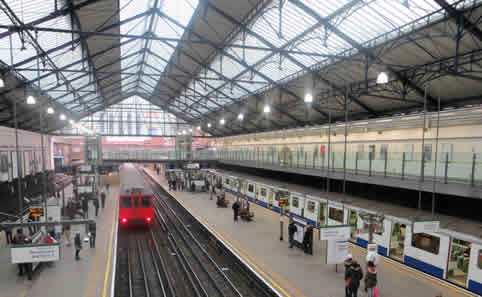
For the visitor to London the Underground or Tube will probably be the transport of choice to get around town. The Underground is normally the fastest way to get around town, often much faster than any taxi.
There is invariably an underground station nearby where you want to go and also your hotel and finding your way around the system is very easy.
There are currently 13 Underground lines, with the Elizabeth Line the latest, which opened in May 2022.
Journey planner Map DLR, overground & TfL Oyster card, contactless & Travelcards Night service Fares Concessions Child fares Group tickets Purchasing tickets Access

Key points about the London Underground
It is still encouraged to wear a facemask when using public transport in London, but it is no longer mandatory.
The authorities penalise you heavily for buying single journey tickets. In the centre you can pay more than double the price than if you used an Oyster Card for example.
A single journey on the London Underground can involve 1 or 2 changes of train. Your journey starts when you go through the ticket barrier of the station entrance you depart from and finishes when you pass through the ticket barrier at the exit of your destination. You cannot break a journey on a single fare, once you go though an exit barrier of a station that is journey completed.
The buses, Underground, DLR and London suburban trains are managed by a central government body called Transport for London (TfL) chaired by the Mayor of London. The transport passes that nearly everyone uses, Oyster and Travelcard, allow you to travel seamlessly across all modes of transport, bus, Underground, train and DLR using the same ticket/pass.
Children under 11 travel free on the London Underground and DLR (Docklands Light Railway) at all times. Child fares are available for those under 16 and it is possible to get discounted fares if you are under 18 or studying in London with an ID card.
There are no seniors fares for visitors. If you reside in London and are over 60 you can get a pass that makes free bus and Underground travel available. If you have an English National Concessionary bus pass you cannot use it on the London Underground (but you can use it on London's red buses).
The London Underground is closed from around midnight until around 5am, getting started a little later on Sundays. However on Friday and Saturday nights, much of the Underground runs through the night. In Central London there is a very good night bus network when the Underground is closed.
You will rarely have to wait more than 5 minutes for an Underground train at any time of the day.
London Journey Planner - for all types of transport across London
Use the TfL (Transport for London) journey planner to plan your travel. The journey planner covers all public transport.
TFL Journey planner

London Underground map
The London Underground map is a classic design that when first launched was immediately taken up worldwide for similar systems. The clarity, simplicity and ease of use compromises strict geographical accuracy.
The Circle line doesn't really go around in a squashed circle and it is not apparent for instance that Bayswater Underground is only 100 yards from Queensway.
In 2016 the Night Tube was introduced. On Friday and Saturday nights only Underground trains run through the night. For lines that operate a night service see the Night Tube map linked below or on the right-menu.
In May 2022 the long awaited Elizabeth Line opened its first section. The Elizabeth Line provides a route connecting East and West London. Find out more about the new Elizabeth Line .
Underground map Tube & rail map Night tube map
Docklands Light Railway (DLR), overground and TfL rail trains
To the east of London in the Docklands region you will see a region covered by something called the DLR (Docklands Light Railway). You can treat this network as just another Underground line.
Not in the centre of London, but in the suburbs you will find a train network called the Overground which can also be thought of as being part of the Underground for ticketing purposes.
Commuter trains into the suburbs are very confusing for the visitor. You can still use Oysters and Travelcards on these but those lines run by the national railways only give free travel to children under 5.
In the north and east of London most of these services are now run by TfL Rail or the Overground so free travel is available to children under 11, but to the south and west of London, services are still dominated by national railways companies.
The Tube and rail map usefully shows which railway stations are in which travel zones. Travel zones are the basis for fare charges on London's railways and Underground system.
London Underground Night Service - the Night Tube
In 2016 the London Underground began to introduce a full 24/7 service on Friday and Saturday nights only. Introduction has been on a phased basis.
Night Tube services are now running on the Central, Victoria, Jubilee line, Northern line (Charing Cross branch) and Piccadilly line (but not Acton to Uxbridge branch). The Night Tube will offer a 24-hour service on Fridays and Saturdays. Standard off-peak fares are levied for travelling on the Night Tube using Oyster and Contactless cards.
Travelcards are valid from the first day of issue (using the date printed on the card), and for journeys starting before 4.30am the following day. For example, if you buy a 1-day Travelcard at 11am on Friday, you can use it until 4.29 on the following Saturday.
Night Tube map - current lines operated
London Underground fares
The London public transport system is divided up into zones that radiate from the centre. Nearly all the hotels and the main sights are in Zone 1. Heathrow Airport is in Zone 6 and the furthest zone out is Zone 9.
The majority of visitors will only travel in the two most central zones 1 and 2. The Underground Map (link above) has the stations and their zones marked.
Some stations, such as Turnham Green, are in two zones. You use whichever zone for these stations is most beneficial in working out your fare.
Underground fares
You can see from the table below there is big financial incentive not to purchase individual tickets and use an Oyster card or Contactless payment card .
The other main way of paying is purchasing a Travelcard , which is a pass giving you unlimited travel for a set time period. The cost goes up with the coverage of zones required. The more zones you require the more expensive the Travelcard.
London Underground Fares from 3 March 2024 - March 2025
Oyster cards, contactless payment cards & travelcards.
As you can see from the above fare structure the authorities do not want you to buy single tickets, they want you to purchase one of the three payment options, Oyster cards, Contactless payment cards or Travelcards.
The Oyster card is a permanent reusable electronic ticket which is topped up from time to time by its owner. Londoners also have their season tickets loaded onto Oyster cards as well and there are passes for one weekly and monthly durations. All can be loaded onto the one electronic Oyster card.
Contactless cards are standard credit or debit cards that support the contactless payment technology, the total cost of all the journeys that you make in one day is calculated at the end of the day and a single charge is made to your Contactless payment card account.
Unlike the Oyster card the contactless facility has a 7-day cap as well as the Oyster daily cap used by Oyster.
You can use Oyster cards on all of London's public transport, not just the Underground, but buses, overground, DLR, suburban rail services and some river services.
Travelcards are another alternatives. Travelcards are valid on the same modes of transport but are unlimited travel passes for a fixed flat fee. Travelcards are available for 1 and 7 days, 1 month and 1 year durations.
You can purchase and subsequently top up Oyster cards and Travelcards from Underground stations and a wide variety of other outlets throughout London including neighbourhood stores, but not Contactless payment cards.
Oyster cards - more details
Contactless payment cards - more details
Travelcards - more details

Seniors concessions
There are no seniors fares for visitors. If you reside in London and are of pensionable age you can get a Freedom pass giving free travel. If you are 60+ and live in London the Seniors Oyster ID Card that makes free bus travel available. You can apply online or get a form from your local Post Office.
Anybody with an English National Concessionary bus pass can use that on London's red buses too and travel free of charge.
If you have a Senior Railcard you can get your 1/3 discount on off-peak Oyster fares. You have to ask a member of staff to load the concession on to a standard Oyster card (note, not a Visitor Oyster card) at an Underground station after showing your Seniors Card.
If you have a Senior Railcard you can also buy a 1 day off-peak zone 1-6 Travelcard at the discount applied.
Child concessions
This is a very complex subject and is covered in detail in the table below. Generally, a child is defined as under 16 years old, but in the last couple of years it has been possible to get child fares after jumping through a few hoops up to the age of 17.
Children under 11 can travel free on the London Underground, DLR and buses without a ticket. If a child is between 11 and 15 years old, you require an Oyster 11-15 Photocard (which has a fee, see below). This allows 11 to 15 year olds to travel at child fares on the Underground, DLR, Overground and some trains, free on the buses.
If you are a short-term visitor (in London for up to 14 days) with kids between 11-15 you can take advantage of the Young Visitor Discount. This means you can get half price fares on an Oyster card on a temporary basis for your child without going through the hoops and expense of getting an Oyster ID card. You do need to read carefully the rules of this scheme though.
Children's Fare Concessions
Group tickets - 1-day group travelcard for groups of 10 or more.
This ticket is for groups of 10 or more travelling together.
This in scope is the same as a 1-day off-peak Travelcard for zones 1-6 and 1-9 providing unlimited travel on all services after 9.30am Monday to Friday and all day Saturday, Sunday and Bank Holidays.
The pricing is particularly attractive if you have kids in the group and those staying in one of the outer zones, however if you are staying in the centre of London zones 1 to 3 it will be cheaper to purchase individual Oyster cards.
If you are a group of 10 or more then do check out this product.

Purchasing tickets & fares levied
There are no longer manned ticket offices at Underground and DLR stations. All tickets are dispensed by ticket machines in the ticket hall and there will be a member of staff hanging around these.
The same machines will allow you to top up your Oyster cards or see what the balance is on your Oyster card and they will also allow you to cancel your Oyster card and get your deposit and any cash left on the Oyster refunded.
If you prefer talking to people selling the tickets there are Oyster ticket stops. These are many of these and typically are convenience stores or news-stands that sell public transport tickets as a sideline. These outlets will have a sign in their front window.
The fare you pay is set by which zone your departure and destination stations are in. Your journey starts when you go through the ticket barrier of the station entrance you depart from and finishes when you pass through the ticket barrier at the exit of your destination. You cannot break a journey on a single fare, once you go though an exit barrier of a station that is your journey completed.
Access to platform & luggage
To gain access to the platforms, and again to exit a station you have to pass through automatic barriers (pictured). There is always one wide ticket barrier for wheelchairs, pushchairs and people with large suitcases.
If you have a single ticket, the barrier at your destination will not return your ticket. There is a manned side gate by the barriers. If you have a Travelcard you insert the Travelcard into the same slot as for the single tickets, the barrier will check that your Travelcard is valid for both date and zones travelled.
If you have an Oyster card or Contactless payment card you swipe the card over a bright yellow pad, the barrier will check validity and will record the station you have started your journey before opening the barrier. The barrier may display the balance on your Oyster too.
At your destination station, exiting through the barrier in effect tells the system you have ended your journey and it works out the fare to be deducted from your card.

BUY VISITOR OYSTER CARD & TRAVELCARD FOR LONDON
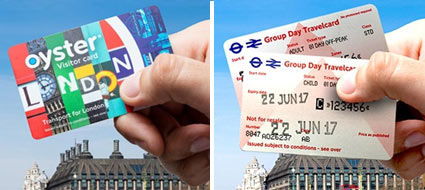
Visiting London? Save time and money on London public transport
• Visitor Oyster Card • Travelcard for 1 day anytime / off-peak or 7 days anytime • Group day travelcards available
LONDON TUBE MAPS (PDF)

London Underground: How to pay fares & use tube trains

How much is a London train fare?
- Adult train fares 2024
- Senior train fares 2024
- Child train fares 2024
You can buy tickets using cash, your contactless card , or by getting hold of an Oyster card , Visitor Oyster card or travelcard .
Tube journey planner
Get information about a station:
Plan a route between two stations (remember to check for tube strikes and delays ):
Where can you get a tube map?
Free maps can be picked up inside tube stations in the most central, touristy parts of London. The best online map is at the TFL website: tfl.gov.uk/standard-tube-map.pdf .
Where can you get London underground timetables?
Paper timetables – You can get paper timetables from one of the Visitor Centres at Heathrow airport, Euston station , King’s Cross , Liverpool Street , Paddington , Piccadilly Circus and Victoria .
Online timetables – You can also look them up on the TFL website at tfl.gov.uk/travel-information/ – or this very website, by selecting a station from the dropdown menu above.
Download the TFL app – The official TFL app is worth downloading onto your phone because it comes with a tube map and route planner. Check out their website for details: tfl.gov.uk/maps_/ .
When is rush hour on the London underground?
Rush hour on the London Underground is slightly different to peak time , and runs roughly from 7.30 AM to 9.30 AM, and 5 PM to 7 PM – don’t expect to get a seat during rush hour!
Peak time is used to work out the fare, and applies from 6.30 AM to 9.30 AM, and 4.30 PM to 7 PM (Mon-Fri). Weekends and public holidays are always classed as off-peak . Note: Between the 8th March and 31st May 2024 TFL are running a trial called ‘Off-Peak Friday Fares’, where Fridays will be classed as off-peak all day.
How often do London underground trains run?
How often London underground trains run will depend on which line you’re using and the time of day you’re travelling, but a good rule-of-thumb is every 5-10 minutes in zone 1, going up to every 2-5 minutes during rush hour. Trains outside zone 1 can be anything from 10-30 minutes.
Services typically operate between 5 AM and 00.30 AM (Mon-Sat) and 7 AM to 11.30 PM (Sun), but some of the busier lines operate 24 hours a day on the night tube.
You can view of a map of the night tube routes on the TFL website .
When does the night tube operate?
Central line – Trains run roughly every 10 mins between White City and Leytonstone, every 20 mins between Ealing Broadway and White City, and every 20 mins between Leytonstone and Loughton/Hainault. There’s no night service between North Acton and West Ruislip, Loughton and Epping, or Woodford and Hainault
Jubilee line – Trains run roughly every 10 mins
Northern line – Trains run roughly every 8 mins between Morden and Camden Town, and every 15 mins between Camden Town and High Barnet/Edgware. There’s no night service on the Mill Hill East branch or Bank branch
Piccadilly line – Trains run roughly every 10 mins between Cockfosters and Heathrow T5. There’s no night service on the T4 loop, or between Acton Town and Uxbridge
Victoria line – Trains run roughly every 10 mins
How can you avoid lifts and escalators on the tube?
Avoiding tube stations with lifts and escalators is harder than you’d think because a lot of them are very old and don’t have lifts, or even escalators, so the odds are pretty high that you’ll find yourself facing a long flight of stairs at some point.
If you look on a tube map then the stations showing a blue wheelchair symbol have step-free access between the train and the street, so these ones should be accessible for practically everybody, but the ones with a white wheelchair symbol only have step-free access between the platform and the street, so you might need some help getting on and off the actual train.
The journey planner on the TFL website will let you search for a route with extra options like ‘Use escalators but not stairs’ – tfl.gov.uk/plan-a-journey/ .
How can you avoid tunnels on the London underground?
If you’d rather avoid tube tunnels on the underground then you’re out of luck in central London because the journeys in zones 1 and 2 are practically all underground.
Once you get out to zone 3 and beyond then it’s the total opposite, because most of them are above ground.
Check out this handy map on the TFL website which shows you which parts are above ground: tfl.gov.uk/tube-map-with-tunnels .
Can you take a bike on the London underground?
Non-folding bikes are banned on large parts of the London underground because the tube trains are so busy. Check out this handy map on the TFL website showing you which stations allow them: tfl.gov.uk/cycles-on-public-transport-map .
How do you get through the ticket barriers?
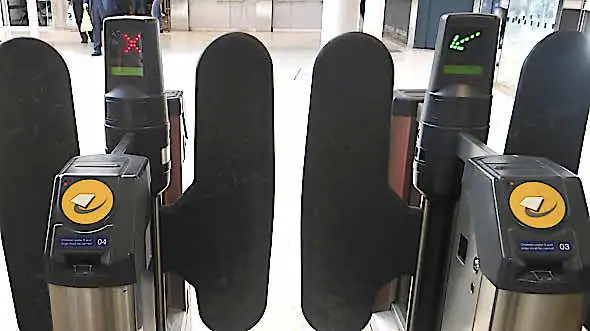
The first thing that you need to know is that you can’t get through every single barrier at the station. You can only use the ones that are showing a green arrow or yellow arrow next to the gate. If it has a red cross or yellow cross then it won’t accept your ticket.
The yellow circles in front of the gates are called Oyster readers. If you have an Oyster card or contactless card then all you have to do is wave it near the reader and the gate will open automatically. If you have a paper ticket, or a paper travelcard , then you have to insert it face-up into the slot beneath the Oyster reader. The same ticket will then pop out of the slot on the top. The gate will open automatically when you remove your ticket from this slot.
Note: If you’re carrying some bulky bags or you’ve got a pushchair with you, then you might struggle to fit through the barrier. So just look for the extra-wide barrier which is usually positioned at the far end for wheelchair users. This one is also useful if your child is travelling for free because they won’t have their own ticket.
How can you find the right platform?
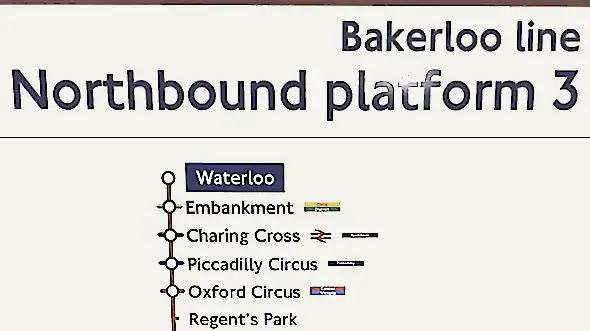
To find the right tube platform you need to know your direction of travel. If you want to travel from Piccadilly Circus to Oxford Circus on the Bakerloo line, for example, then you need to look for signs saying Bakerloo Northbound , because that’s the direction you travel on the ground. If you’re returning in the opposite direction then you’d need Bakerloo Southbound . Other journeys might say Eastbound or Westbound .
If an underground line branches in two different directions then you also need to look for the last stop on the line. So if you want to travel from Westminster to Kew Gardens on the District line, for example, then you need the District Westbound to Richmond – because Richmond is the last stop on the branch which goes to Kew Gardens. If you boarded the District Westbound to Wimbledon then that would be the wrong one, because that branch doesn’t go to Kew Gardens.
The Northern line is a bit more confusing because not only does it split in two, but each branch also has the same final stop. So what you have to do then is look for the words Bank loop and Charing Cross loop . If you look on a tube map then you’ll see that one branch goes past Bank station , whilst the other goes past Charing Cross .
And bear in mind that the Circle line doesn’t actually go around in a circle, like its name implies (welcome to London!). If you ride it round as far as Edgware Road then you’d actually have to get off and board another train to Baker Street .
What is a National Rail train?
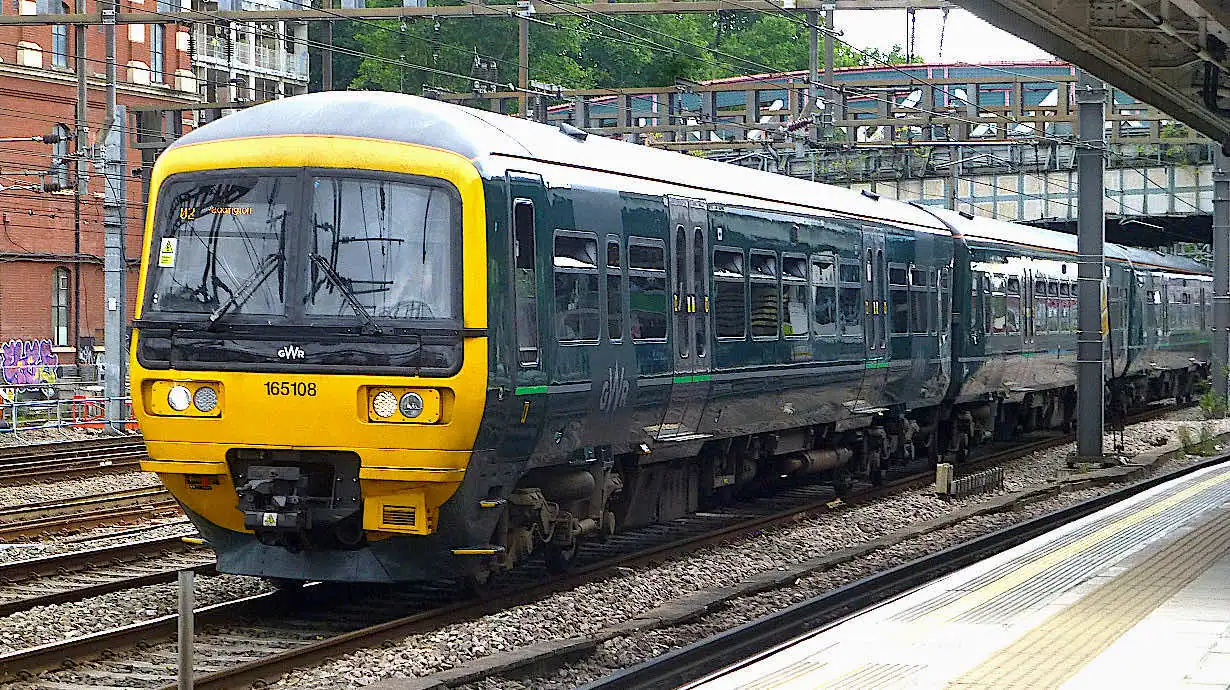
A National Rail train is an overground train that goes outside London to other parts of the country.
There are lots of different companies that operate National Rail trains: Chiltern Railways, East Midlands, First Great Western, Great Northern, Merseyrail, South West Trains and Thameslink , to name just a few, but they all come under the umbrella of ‘National Rail’.
Each company will have their own individual website, but we recommend using the official National Rail website at nationalrail.co.uk , because it allows you to search all of the different companies together.
Where can you catch a National Rail train?
Here’s a list of the main National Rail stations in central London, with some of their most popular destinations.
Trains heading north – City Thameslink for Luton Airport, St. Albans – Euston for Birmingham, Glasgow, Liverpool, Manchester, Watford – King’s Cross for Cambridge, Edinburgh, Newcastle, Nottingham, York – Marylebone for Birmingham – Moorgate for Hertford – St. Pancras for Luton Airport, Nottingham
Trains heading south – Blackfriars for Ashford International, Brighton – Cannon Street for Ashford International, Margate – Charing Cross for Canterbury, Dover, Hastings – Farringdon for Brighton – London Bridge for Brighton, Canterbury, Hastings – St. Pancras for Brighton, Eastbourne, Eurostar to Paris – Victoria for Brighton, Dover, Eastbourne, Gatwick Airport, Margate – Waterloo for Bournemouth, Canterbury, Dover, Hastings, Portsmouth, Southampton
Trains heading west – Paddington for Bath, Cornwall, Heathrow Airport, Oxford, Plymouth, Wales – Waterloo for Cornwall, Salisbury
Trains heading east – Fenchurch Street for Southend – Liverpool Street for Stansted Airport
Good manners and bad etiquette on the train
If you’re new to the London Underground then here’s a quick little guide to tube etiquette:
Getting through the barrier – Tube stations are very busy places and you should always try and have your ticket ready before you reach the barrier. If you stand there for a few minutes rifling through your pockets and bag then expect to get some withered looks.
Standing on the escalator – The biggest sin that a tourist can commit on the tube is blocking up the escalator by standing on the left. If you want to stand still then use the righthand side. The lefthand side is for people who want to save some time by hurrying up it.
Not quite as annoying (but pretty close!) is when people get to the end of the escalator and then just stand there, totally oblivious that a whole bunch of people are about to crash into the back of them.
Standing on the platform – Underground platforms are usually quite long but lots of people just stand by the entrance corridor, not bothering to move down. If the station is busy then you should always try and move along to make more space.
Getting on the train – It’s good manners (and good sense) to let passengers off the train before you try and board it. You should also try and move down inside the carriage once you’re onboard.
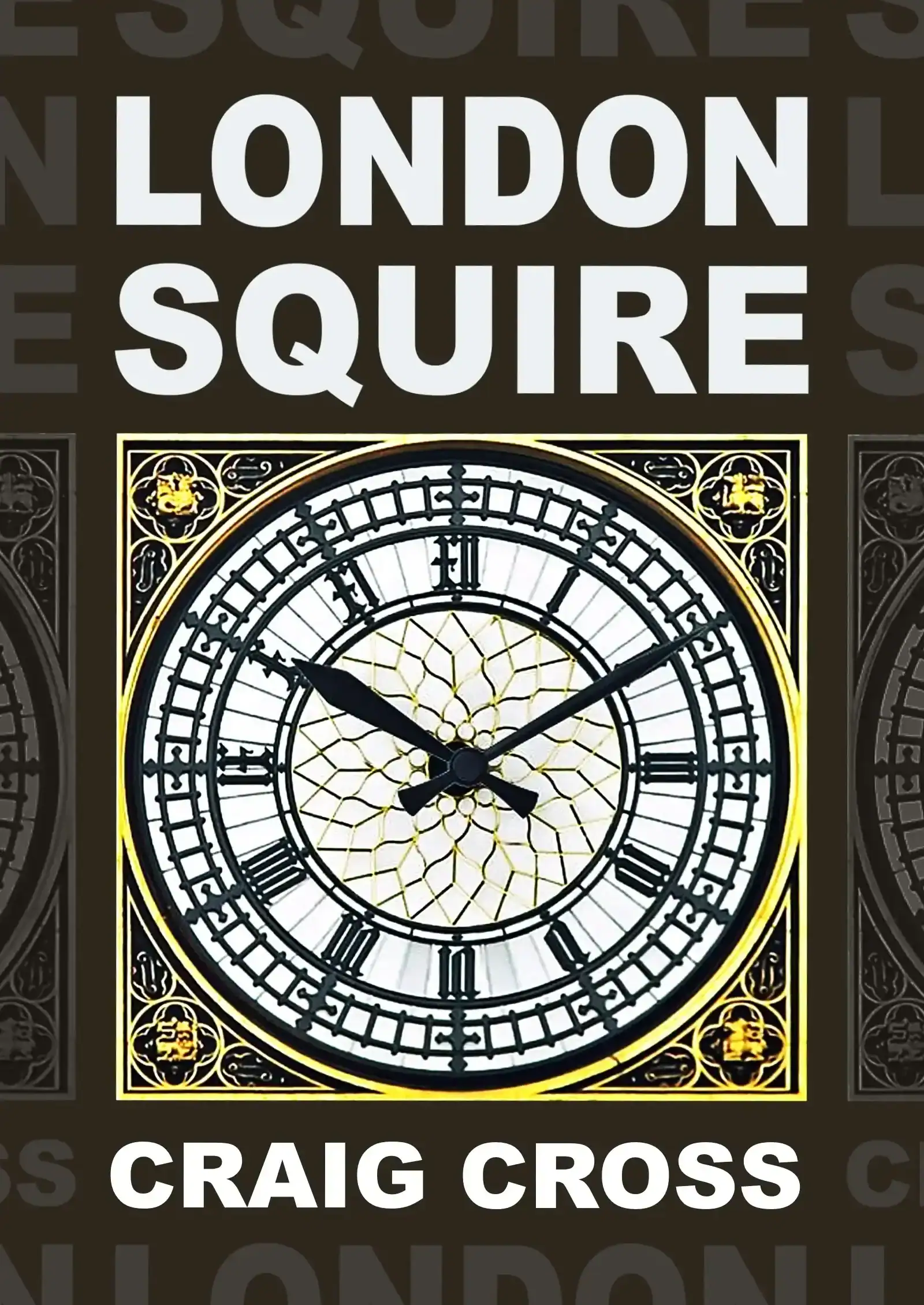
Your comments and questions
Jean I'm traveling with my 15 month old daughter how easy is it to access the underground as I have a buggy
Staff Hi. They always have extra wide gates for wheelchairs and buggies at the entrance, so you can get through there okay, but a lot of underground stations still have stairs. If you enter your route into the journey planner dropdowns above it will tell you about the lifts, escalators and stairs at each station
John Hardman Transport for London is so good, people in London don't realise how lucky they are to have such a great transport system and with reasonable fares. True I am talking about being retired and travelling off peak. Recently stayed 5 days in Crystal Palace. Travelled into London each day by train and fully utilised the tube system. I almost enjoyed that as much as looking around London
Margaret49 Good morning, We are using the tube for the first time for an overnight stay, as we are not local we will need to use the self service ticket machine for Zone 1-4, do the machines take cash or credit cards? So we know what is appropriate for our journey which will involve a peak time inward and off peak return
Staff Some machines accept cash and cards but other ones will be labelled 'cards only', so you have to look at the top to see what it accepts. All the peak and off-peak prices for zones 1-4 are listed on our train fares page - city-guide.london/transport/adult-train-fares.php
Sammy Hi, what are peak times as underground cheaper tickets are off peak, but what times are peak so we know when you avoid them?
Staff Hi Sammy. For Oyster and contactless peak time is 6.30 AM to 9.30 AM and 4 PM to 7 PM (Monday to Friday). For travelcards peak time is before 9.30 AM (Monday to Friday). Weekends are always off-peak.
Tom What are 'off-peak' times on the London Underground on a weekday please?
Staff Hi Tom. For Oyster and contactless cards off-peak is outside the hours of 6.30 AM to 9.30 AM and 4 PM to 7 PM (Mon-Fri). For travelcards off-peak is any time after 9.30 AM (Mon-Fri). Fares are based on what time your journey starts. So if your journey starts during off-peak hours, it will be charged as off-peak. It doesn’t matter what time your journey ends.
David MB Two retired people from US in London (no senior discounts for non-Londoners, boo!), travelling on probable multiple trips between Zones 1 and 2 back and forth from Aldgate East. We understand fares are one way and with the limit on Oyster Cards being less than double the one way fare, what is the cheapest way for us to use the underground? We will buy tickets to and from airports separately
Staff Hi David MB. Oyster will likely be the cheapest (a weekly travelcard can also work out cheaper depending on how many days you're staying and how many journeys you're making). The maximum you will pay each day is the daily cap for the zones you travel through, Any money left on your card which you don't spend you can get refunded at the end. If you're flying into Heathrow then you can even use it for that as well (but only for travelling on the tube, not the Heathrow Express)
Jagroy Is there any charge for a pushchair on the tube
Staff Hi Jagroy. There's no charge for pushchairs or luggage, but bear in mind that a lot of underground stations are quite old and you might have to descend a flight of stairs
Gary Tamplin Generally speaking, what is the cheapest way of getting around London for a day on the tube, if you are travelling between most of the zones, a day Oyster card or contactless?
Staff Hi Gary. Oyster and contactless are the cheapest (they're both the same price), but you have to pay an extra £5 deposit the first time you buy an Oyster card, so maybe contactless will be cheaper for you if you haven't already got one
Adriana How do I get from ealing broadway to hammersmith by train
Staff Hi Adriana. You can just get the district line - city-guide.london/transport/train-journey.php?from=ealing-broadway&to=hammersmith
Anthony Pike What platform do I use for the jubilee line from waterloo to baker street
Staff Hi Anthony. The jubilee westbound at Waterloo is platform 5 - city-guide.london/transport/trains.php?station=waterloo
John Barmby I am travelling from Tower Hill to Stratford on the District line and Central As these trains use the same platform at Mile End , do I need to tap out at Mile End before boarding the Central line to Stratford
Staff Hi John. No, you don't have to tap out when changing trains. You don't have to pass through any barriers when changing trains/platforms. If you did go through the barriers at Mile End then that would be the end of your journey
John miller I’m travelling from kings cross train station to white hart lane, what tube station do I get off at?
Staff Hi John. Get the Victoria line to seven sisters, then the London Overground to White Hart Lane. It’s about a five minute walk from there
Liz Is Euston station tube to Clapham Common direct
Staff Hi Liz. It is direct, yes - city-guide.london/transport/train-journey.php?from=euston&to=clapham-common
David Hi - How do get the easiest way with large suitcases from Liverpool Street station to Southwark tube station. Thanks in advance!
Staff Hi David. I would forget the tube and just get the 344 bus which goes between the two. Because you'd have to change trains twice if you want to go by tube. The bus only takes 16 mins
David Thanks - is it ok to take large suitcases on the bus number 344? - Can we pay with Oyster-cards? Thanks! ?
Staff It's fine to take big suitcases. You can just stand with them in the wheelchair space if it's not being used. Its okay to use Oyster cards as well
David Thanks very much for your help! This was important to know! ?
David Hi - One more question. We arrive by National Express coach to Liverpool Street station bus stop. - Where abouts in the area is the nearest bus stop for number 344 going to Southwark. Thanks once again! ?
Staff It goes from Stop B down the side of the station. I think the National Express drops you off at either Stop E or G on the other side.
David Thanks again for great service! ?
Bruce Hello - is there easy access when changing from Central line to Jubilee line at Bond Street. How far must one walk? Is a lift available? All relevant info is welcome. Thanks.
Staff Hi Bruce. It's step-free but you have to take two different lifts down to the jubilee platforms and walk about 110 metres
Bruce Thanks - that helps to know.
Mark Rookie question (I’ve never used Contactless on the Tube before, I’ve always used paper Travelcards as I’m from outside London). Anyway, in terms of using Contactless, if I want to go from Paddington to Mile End am I correct in thinking I tap in at Paddington Elizabeth Line, tap out at Whitechapel Elizabeth Line, tap in again at Whitechapel District Line, tap out Mile End District Line, and the system will calculate this as an Adult Single between Paddington and Mile End?
Staff Hi Mark. You only tap down at the beginning and end of your journey. You shouldn't have to go through any barriers when changing trains in the middle. If you do that then you'll end up paying for two separate journeys, because the computer will think that you have exited the station at Whitechapel
Sonia Hi, If I travel with 2 suitcases (a 20 inch and a 28 inch), from Victoria to Gatwick airport, which one will be cheaper - the National Express coach or the Gatwick express (as I read from the website that they will charge 8 GBP for 1 extra suitcase)?
Staff Hi Sonia. It looks like it's the Gatwick Express by about 6 quid, but that's without knowing when you're going, or how far in advance you're buying your ticket.
Anton John Hi, What would be the most cost effective way to get from Bromley by Bow station to Gatwick Airport ? Thanks
Staff Hi Anton. I would get the underground to Victoria and pay by contactless (or buy a single ticket from the machine if you haven't got a UK bank card), and then buy a Gatwick Express ticket online in advance
Faye McPherson I want to travel to London Heathrow Terminal 3 from Russell Street Station on 22nd February as I will be coming from Edinburgh on the sleeper to Euston where do I buy a ticket to get to Heathrow
Staff Hi Faye. The easiest thing would be to just use your contactless bank card, and tap it down on the gate - city-guide.london/transport/contactless-cards.php (assuming you've got a UK bank card) - but if it's just a one-off journey then you can also buy a ticket from the self-service ticket machine in the station. You just tap the screen and choose your destination
Faye McPherson Thank you and I take it the tube takes me to terminal 3 at Heathrow
Staff It does yes, there are three stations at Heathrow and one of them is for Terminals 2&3 - city-guide.london/transport/train-journey.php?from=russell-square&to=heathrow-terminals-1-2-3
Chris For our upcoming visit to London, we are staying in a flat near Shepherd's Bush. It looks like the easiest (fewest changes) route from Heathrow would be the Elizabeth Line to Ealing Broadway and then the central line to Shepherd's Bush. Would this be feasible with 4 people and their luggage?
Staff Hi Chris. You'll have a flight of 20 stairs and an escalator at Shepherd's Bush, but that's about it. If you don't mind the extra money then you could get the Heathrow Express to Paddington and a £25-£30 taxi to Shepherd's Bush (you can fit five in a taxi, so four plus luggage will probably be okay, but it depends how much luggage you've got)
Cp On the underground should my 15 year old just use a contacless card to pay or is there a better method?
Staff Hi CP. he can do, if he’s got his own card. You can’t share one card between two people
shirley How oftern to the trains go from Heron quays to waterloo
Staff Hi Shirley. They go every 2-5 minutes
Evelyn Barry Hi I have my Irish staff privilege card and 4 box coupon tickets . Can I use either of these on Heathrow express and London tubes. Thanks
Staff Hi Evelyn. We’d like to help but we’ve never heard of either of those things. If it’s a TFL staff card then I would try contacting them
Mike Copp As an electric wheelchair user (wheelchair not scooter) I will arrive at Waterloo Train station and have booked assistance off the train, will someone be available to assist me on to the underground to Euston station? where I have booked assistance onto a train to Birmingham? I am used to how assistance works with overground trains but not the underground. I believe my ticket is valid not only for overground but also between mainline stations using the underground.?? Any information, tel no appreciated
Staff Hi Mike. You can only prebook assistance on the London Overground and Elizabeth line. On all other tube lines they do something called ‘turn up and go’, which basically means you have to go up to a member of TFL staff at the station and they will arrange for someone to come and help you to the platform and help you board the train. There is a help desk at waterloo. after you come off the national rail train look for the big central clock hanging off the ceiling and its next to that. More information about ‘turn up and go’ here - tfl.gov.uk/transport-accessibility/help-from-staff . We cant tell if your ticket includes the underground as well without seeing what you've bought, but assuming it does then you’ll probably receive a separate ticket for it.
Jane What's the best line to use to travel from Paddington station to Greenwich?
Staff Hi Jane. Assuming you just want to go to Greenwich, the place, rather than the actual station, I would get the Elizabeth line to Canary Wharf and then the DLR to Cutty Sark
Vijay kumar I am travelling first time to London.Which u/g line i should follow from T4 to Queensway u/g stn.I do not have travel cards.
Staff Hi Vijay. i would probably get the Elizabeth line to Paddington and then walk 15 mins to Queensway. Otherwise you”ll have to get off at Bond Street instead and change onto the Central line for Queensway
Jane Hi my grandson and I are going to Wimbeldon tennis this year and haven’t a clue on the underground tubes.we are travelling from Northampton train station to Euston station.can you please let me know what tubes we use ,if we change tubes and what stops to get off and platforms .
Staff Hi Jane. It's quicker to go to Southfields station (15 min walk to the tennis) rather than Wimbledon itself (20 min walk). So from Euston you can get the Victoria line to Victoria (southbound platform), then change to the District line to Southfields. But make sure you get a District line train that says it's heading towards Wimbledon. If it says it's heading towards Richmond or Ealing Broadway then it will be the wrong one. It will say where it's heading on the LCD board on the platform
Elizabeth wills Which platform at farringdon station do I need to get to kings cross please?
Staff Hi Elizabeth. It's westbound, platform 2 - city-guide.london/transport/trains.php?station=farringdon
Paul G Going underground from Clapham Common to Westminster abbey and Buckingham palace using contactless card. Do we get off at st James park or is there a closer station and do we need to pay twice for changing from northern line to district line. Thank you
Staff Hi Paul. St James's is the closest to Buckingham Palace. Westminster is the closest to Westminster Abbey. Personally, if it was me, I would just stay on the Northern line and walk it from Charing Cross because it's not very far. You can walk past Trafalgar Square down Whitehall, have a look at Horse Guards and Downing Street, then do Westminster Abbey, and walk through St. James's Park alongside the lake to Buckingham Palace. You don't have to pay twice for changing trains. You'd only pay twice if you actually exited through a ticket barrier and left the station.
Joe Hi. Visiting London next week for first time and need to get from King’s Cross to Covent Garden Seven Dials. What tube line and can it by accessed directly from Kings Cross? Thanks
Staff Hi Joe. You can get the Piccadilly line straight to Covent Garden - city-guide.london/transport/train-journey.php?from=kings-cross-st-pancras&to=covent-garden
Mary I’m travelling from London City Airport to Westminster early December and as I’m a novice it feels a bit stressful. Can you please advise me of the best way to travel and is it straightforward? Thank you.
Staff Hi Mary. I would get the DLR to Canning Town (DLR = Docklands Light Railway, which is really no different to using the London Underground, it’s just above ground), and then change trains onto the Jubilee line for Westminster. You can use a lift plus escalator to change trains at Canning Town - city-guide.london/transport/train-journey.php?from=london-city-airport&to=westminster —- westminster is a fun stop to arrive into London at, because when you come out you will have Big Ben literally right in front of you
Mandy How to get from st pancas to king henrys rd
Staff Hi Mandy. Assuming you mean the one by Primrose Hill, you could get the northern line to Chalk Farm and then walk it from there. It's about a 10-15 min walk
You must enable javascript to leave a comment
> Forum: London Buses, Taxis & Trains
London Tube Fares 2024
Transport fares vary depending on when and where you travel, and on the payment method you choose.
Time of the day:
If you travel during peak hours, costs will be more expensive than during off-peak hours. Peak hours are Monday to Friday, between 6:30 am to 9:30 am, and between 4:00 pm to 7:00 pm, except on public holidays.
Ticket type:
- Paper ticket or cash ticket: Single tickets cost between £6.70 and £9.80 .
- Pay-as-you-go (PAYG) or contactless payment methods: By using an Oyster card, which is a prepaid or contactless option, you can save significant money on each journey. For example, if you use it in Zone 1, your ticket will cost less than half the price of a paper ticket. It is worth learning more about this money-saving payment option; see below for more information.
Distance between stations:
When you are in front of the ticket machine, first you must choose the zones you will be travelling through in the next few days. If you are a tourist, you will usually travel within zones 1 and 2. Our suggestion is to select this option because it is where you will find the most famous attractions in London.
Another tip is to add enough credit for 3 days' travel, for example for a family of two adults and two kids: £20 per adult and £10 per child under 15.
Children under 15 are eligible for discounts and free travel. Children aged 5 to 15 pay half the adult fare, while those under 5 travel for free. To access these discounts, ask for assistance at the station; TfL staff will help you.
You must scan your card or ticket at the ticket barrier's reader upon both entering and exiting the Tube platforms.
Oyster Card and Travelcard
When travelling in London, using a prepaid card such as an Oyster Card or Travelcard is the savvy way to go. Not only do these cards offer cheaper fares compared to paying with cash, but they also come with daily spending limits to help you save even more.
The Oyster Card, costing just £5, can be ordered online and sent directly to your home before you arrive in London. Once you have it, you can top it up with as much credit as you need. This credit doesn't expire – it's yours to use whenever you're in London. Travel on the Tube, buses, and other TfL services becomes more cost-effective, thanks to the daily caps on spending. For example, if you hit the daily cap of £8.50 with an Oyster Card, you won't pay a penny more for any additional trips that day.
Remember, if you don't use all your credit, you can easily get a refund for up to £10 at any ticket machine – although the initial £5 cost for the card itself isn't refundable. The card is reusable for your next visit, though!
And if you prefer to travel light, you can tap in with a contactless bank card. Just keep an eye on any potential bank charges. Similar to the Oyster or Travelcard, contactless bank cards also benefit from a daily cap on charges, ensuring you don’t spend more than a set amount each day, regardless of how many trips you make.
Here are the tables that outline the fare caps and Travelcard prices:
Pay as you go (PAYG) caps: For trips on the Tube, DLR, London Overground, TfL Rail, and National Rail, there are daily and weekly spending caps that apply.
Travelcards: These cards give you unlimited travel within the chosen zones and are available for different lengths of time.
We highly recommend using a card when travelling around London – it's cheaper than cash and caps your daily spend. Grab an Oyster Card or a Travelcard for just £5. They're both prepaid, which means you can add money to them and only pay for the travel you use.
Before you come to London, you can buy an Oyster Card online and have it sent to your home. It's a durable card that never expires, ready for your next London adventure.
In addition to the Oyster Card, the Travelcard is an excellent option for those planning to make extensive use of public transport. You can purchase a Travelcard for periods of 7 days, a month, or even a year, making it ideal for regular visitors or residents of London. Unlike the Oyster Card, which charges per trip up to a daily cap, the Travelcard allows you unlimited travel within the zones you have selected, without concern for the number of trips you make.
For added convenience, both the Oyster Card and Travelcard can be topped up online, at ticket vending machines, or at any London train or Tube station. With these cards, you can fully enjoy all that London has to offer, moving around the city efficiently and cost-effectively.
Where to buy tourist tickets online?
Questions and answers.
Where can I buy tickets to travel on public transport in London?
- Tickets and prepaid card top-ups can be purchased at the ticket machines that can be found at the Tube stations. You can pay by credit/debit card or in cash (coins or notes). Ticket vending machines are available in different languages.
How much do young children pay on London transport?
- Children under 5 travel free with a fare paying adult.
- Children aged 5 to 10 travel free on buses and trams with an Oyster card, no ticket needed.
- Children aged 11 to 15 can receive the following benefit through an Oyster card: 50% off adult-rate pay-as-you-go fares and daily caps on a bus, Tube, tram, DLR, London Overground, Elizabeth line, National Rail services, and London Cable Car.
For more information on discounts, visit the official transport website . Tourists should note that the Oyster Card can be bought online before travelling to London and be delivered to their home address. The card costs £5. Then you decide how much credit you want to top it up with. This prepaid card has no expiry date.
Where can I find precise information for the rest of the fares and tickets?
- You can find detailed information on all fares and tickets in the official announcement regarding the March 2024 prices, available at this link: www.london.gov.uk/media/104143/download .
If you notice any errors on this website or have any suggestions, please use our contact form , and we will try to solve the problem as soon as possible.
Thank you for visiting our London Tube fares page, we hope you found it useful.
London tube map | Timetable | Fares | All subway lines
Understanding Zones And Fares For London Tube Tickets

The London Underground network is a massive transportation system that serves millions of passengers each day. It is the world’s oldest underground railway network and the most extensive public transport system in London. To navigate the Tube, passengers need to be familiar with the zones and fares system. Understanding this system can save you time and money, making your journey in London more enjoyable.
The Tube system is divided into zones, which are concentric circles radiating out from the city center. These zones determine the price of your journey, and the further out of the city center, the more expensive your ticket will be. There are nine zones in total, and the price of your ticket depends on the zones you travel through.
The fares system works on a pay-as-you-go basis, which means that you pay for each journey you make. However, there are many options available to make your journey more cost-effective, such as purchasing an Oyster card, which is a smart travel card that you can top up, giving you access to cheaper fares.
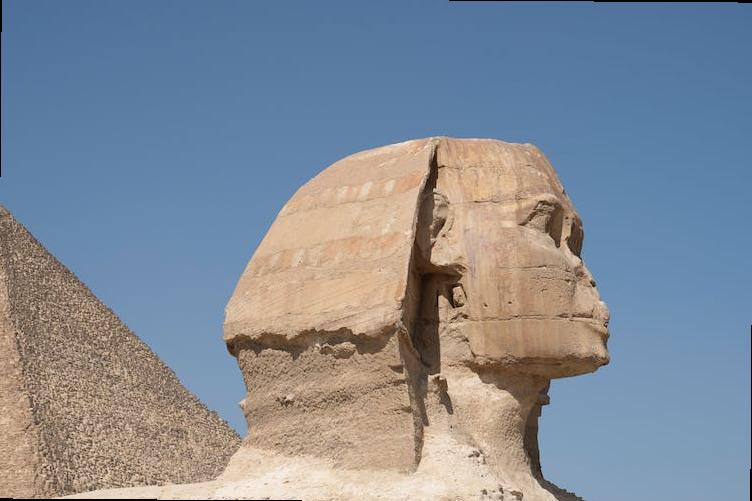
To get London tube tickets, you can purchase them at ticket machines or ticket offices located in each Tube station. You can also buy tickets online or via mobile phone apps. However, it’s essential to plan your journey before buying your ticket so that you can select the correct zones to travel through and get the best fare for your journey.
Fare Structure And Pricing
The fare structure and pricing for London tube tickets depend on the zones traveled and time of travel. The cost of a single ticket can range from £2.40 to £6.00, while a contactless or Oyster card can offer reduced fares for frequent travelers. The travel card and visitor Oyster card offer unlimited travel for a day or week, which is suitable for tourists. Additionally, the off-peak travel fare is also a cheap alternative for travelers who avoid peak time rush hours.
To get London tube tickets, one can go to any station and purchase a single ticket, travel card, or Oyster card. Contactless cards can be used for tap in and out of tubes and buses. Apart from that, online booking of tickets and contactless payment cards can be used which make the ticket purchase process even more straightforward.
If you are wondering what to do in London for fun, why not check out some alternative theatre shows?
Oyster Card Usage Benefits
Oyster Card usage benefits include being able to purchase tube tickets prior to your journey and reload the card as needed. It also allows for quick and easy access through the tube barriers without having to purchase a new ticket every time. The Oyster Card also has daily and weekly fare caps, which means you will never pay more than the daily/weekly cap no matter how many journeys you take. This makes it an economical choice for regular travelers in London. Moreover, the Oyster Card can be used on other forms of transportation in London, such as buses and trains, making it a convenient all-in-one option for traveling around the city. With the Oyster Card, travelers can also receive discounts at restaurants and attractions. Overall, the Oyster Card is a useful and efficient tool for navigating the London tube system, ensuring a hassle-free experience. If you are interested in exploring alternative housing options, check out this guide on how to move out of London social housing.
Paying With Contactless Cards
To get London tube tickets, you can use contactless cards to pay for your journey. When you enter a tube station, look for the contactless symbol to tap your card on the reader. The fare for your journey will be deducted automatically from your card balance. You can use contactless cards issued by Visa, Mastercard, and American Express. Contactless cards have a limit on the amount that can be spent per transaction, which varies depending on the bank that issued the card. If you’re planning to use contactless cards for frequent travel, it’s recommended to check with your bank about any additional fees or charges.
Using contactless cards is a convenient and quick way to pay for your tube journeys without the hassle of buying paper tickets or topping up an Oyster card. It’s also a safe and secure payment method as you don’t need to reveal any sensitive information. Remember to check your bank statements periodically to monitor your spending and report any fraudulent transactions.
In sum, paying with contactless cards is a simple and hassle-free way to get London tube tickets. Just tap your card on the reader and you’re good to go. If you want to avoid overcrowded tourist areas in London, check out our guide on where not to stay in London.
Off-Peak Vs Peak Fares
Off-peak fares are cheaper than peak fares, and they are available outside of the busiest times of the day. Peak fares are available during the busiest times of the day, and they are more expensive than off-peak fares. The London Tube offers both off-peak and peak fares, and to get London Tube tickets, one needs to decide which option they prefer.
Off-peak fares are available during weekdays after 9:30 am and all day on weekends and bank holidays. They are cheaper than peak fares and are great for travelers who are on a tight budget or are not in a hurry. Peak fares are available during weekdays before 9:30 am and between 4 pm and 7 pm. They are more expensive than off-peak fares and are ideal for travelers who need to reach their destination quickly or have a business meeting.
To get London Tube tickets, travelers can buy a pay-as-you-go Oyster Card, which charges off-peak fares automatically. They can also buy a paper ticket at the station or use their contactless bank card to pay for the fare. It is important to note that peak fares can sometimes be double the price of off-peak fares, so it is recommended to plan accordingly.
In conclusion, getting London Tube tickets depends on whether one prefers off-peak fares or peak fares. While off-peak fares offer cheaper rates and flexibility on timings, peak fares are ideal for travelers in a hurry or with time constraints.
Tube Map Reading Skills
Tube map reading skills are essential when buying London tube tickets. Firstly, decide on a starting and ending point along with the intended travel date and time. Obtain a tube map, study and identify the best route to the destination. Choose either a single or return ticket or consider the convenience of an Oyster card or contactless payment card for multiple journeys. Compare prices for peak and off-peak travel, and also consider alternative routes, which may be quicker with fewer changes. Additionally, look out for line closures and delays, which can impact the journey time. At the ticket office, approach the ticket agent, provide the travel details and ticket type, pay the amount due and collect the ticket. Alternatively, Oyster cards can be obtained at vending machines at tube stations or through online purchase, which require activation when first used. Contactless cards can also be used to tap in and out for each journey, with the card balance deducted accordingly. With adequate map reading skills and knowledge on ticket options, travelling on the London tube can be convenient and cost-effective.
Ticket Vending Machines Usage
To use a ticket vending machine to get London Tube tickets, first select “buy tickets” on the main screen. Then, choose the type of ticket you need such as a single, return, or Oyster card. Next, select the number of tickets needed and the zones of travel. After, pay for the tickets using cash or card. Finally, collect the tickets from the dispensing slot on the machine. It is important to note that ticket vending machines are available at all London Underground stations and some other locations such as the airport. The machines have step-by-step instructions in multiple languages, including English, French, German, Spanish, and Chinese. They also have a help button for assistance if needed. It is recommended to use a contactless card for payment to speed up the process. Overall, using a ticket vending machine is a quick and easy way to purchase London Tube tickets.
Single And Return Tickets
The London tube offers a variety of ticket options to choose from depending on one’s travel needs. The two most common ticket options are Single and Return tickets. Single tickets are valid for a one-way journey and can be purchased at the station from a ticket machine or ticket desk. The cost of the ticket depends on the distance between stations and the time of travel. The ticket is valid for a single journey only and must be used within the specified time limit.

Return tickets, on the other hand, offer a round trip journey between two stations. They are also available at ticket machines and ticket desks and the cost depends on the distance and time of travel. Just like the single tickets, return tickets must be used within the specified time limit. However, they offer a cheaper option compared to buying two single tickets for the same journey.
It’s important to note that Single and Return tickets are not valid for travel on any other modes of transport, such as buses or trains. Additionally, there are other ticket options available that may offer greater flexibility and cost savings, such as the Oyster card or Travelcard.
Overall, Single and Return tickets are a great option for those traveling on a one-off journey within London and can be easily purchased at any tube station.


Travelcard And Visitor Oyster Card.
Travelcard and Visitor Oyster Card are two common types of tickets used for travelling on the London underground system.

To purchase a Travelcard, you can either buy it in advance online or in person from a ticket machine, ticket office or a travel information center. It allows unlimited travel on the London underground and bus network, as well as some national rail services within the zones chosen, for a specific period of time, such as one day, seven days or longer.

Visitor Oyster Card, on the other hand, is a smart card that can be topped up with credit and used for pay-as-you-go travel. It can be purchased online in advance or in person from a ticket machine or visitor center. It offers a discounted fare compared to paying with cash, and the card can be used on buses, trams, the underground, the DLR and some national rail services.
Both cards can be used on the same day of purchase and offer convenience for travelers who don’t want to worry about buying individual tickets for each journey. The Travelcard is often more cost-effective for those who plan to use public transport frequently, while the Visitor Oyster Card is better for those who plan to make fewer journeys or those who want flexibility.
Final point
In conclusion, getting London Tube tickets is an essential part of navigating London’s public transportation system. There are various ways to obtain tickets, including purchasing them at ticket machines, ticket offices, or using a contactless payment method. The use of Oyster cards is highly recommended as they offer better value for money and additional benefits such as daily caps and automatic top-ups. Additionally, tourists can purchase Visitor Oyster cards or Travelcards for convenience and unlimited travel on specified routes. Always remember to plan ahead, research online, and consider alternative modes of transportation such as buses or walking when exploring different parts of London. Following these tips will ensure a smooth and stress-free travel experience within the bustling city of London.
To get London Tube tickets, the first option is to purchase them from the ticket machines that are located at the station entrances. There are several types of tickets, including single tickets, daily Travelcards, and weekly Travelcards. Payment can be made using coins, banknotes or cards, and the machine will dispense the ticket with a receipt.
The second option is to visit a ticket office, where a ticket agent can assist with purchasing tickets and provide information on the best routes and fare prices. Alternatively, commuters and visitors can use their contactless debit or credit cards for faster and more convenient payments. The fares are automatically calculated based on your travel routes and will be displayed at the end of your journey.
For visitors, purchasing a Visitor Oyster card is highly recommended. These cards offer discounts on fares and are refundable, making it ideal for those who are only visiting for a short period. Travelcards are another option for those who need a longer period of unlimited travel on the Tube, buses, and other modes of transportation. Remember to plan ahead, check the latest updates on line closures and delays, and consider using the bus or walking to explore the city.
TfL Go: Live Tube, Bus & Rail 4+
Plan journeys around london, designed for ipad.
- #4 in Navigation
- 4.7 • 39.5K Ratings
Screenshots
Description.
Travel confidently around London with maps and live travel updates on our official TfL app. Check live arrival times for Tube, London Overground, DLR, Elizabeth line and Thameslink trains as well as Trams and IFS Cloud Cable Car. Make step-free journeys and look up station facilities. See on the map when stations and lifts are closed. Walking or cycling? Our reliable journey planner will map a safe route. The app is built around our iconic Tube map. To get started: • Touch the map or search to plan your journey • See the status of all lines • Check how busy each London Underground station is right now • Re-route as you travel - we’ll suggest alternatives • Switch to the step-free map for accessible journeys • Find out when your next train, bus or tram is due • Look up which platform your train will arrive on • See when the stations you want to travel through are quieter • Check out station information and facilities such as toilets Most recently we’ve: • Added more information about station toilets – find out where they are by gender and which ones are accessible and/or with baby changing facilities • Built a new map showing nearby bus stops – making it simple to see where you can catch your bus from • Refreshed the navigation – it’s even easier to get to the features you want Our simple and clear layout is designed to make using the app easy for everyone. Planning your journey: We’ll suggest multiple ways to get to your destination – you pick the one that suits you best. Choose the quickest journey, bus-only or one that’s step-free. Check before you travel: See how the line is running and when to expect your next Tube, bus, train or tram Freedom to explore: Choose the right travel options if you or someone you’re travelling with needs to avoid steps, lifts onto a train or in a station. Bus stops near you: Find the bus stop nearest to where you are, and next bus live arrival information for every route. Available underground via Wi-Fi (or 4G in some places) for live updates on the go. What users have said: “I think that out of all of the transport apps I have owned on my phone, this is by far the best” “I love how clean the design of the app is & how easy it is to use. The best part of the app is it’s simplicity & how it helps you to navigate across London so effortlessly.” “The map is awesome! The ability to zoom in and out and see more/less information as you do so. The station information is really useful and seeing which lines/stations are closed or have delays at a glance is really helpful. It’s also beautifully designed! Very slick, clean, and responsive.” “The app is beautifully designed and free to use. Step free mode also works really well." “This is a must have app … very much worth the wait. Well done TFL.”
Version 1.61.0
Improvements to VoiceOver support, plus some other bug fixes.
Ratings and Reviews
39.5K Ratings
Interesting app
Most map apps such as citymapper and google maps bring similar functionality, but the tfl developers have indeed done a good job of providing a well designed and simplified experience with a focus on public transport in London and accessibility (both in the app and in finding accessible transport options). I am particularly impressed with the consistent design style that reflects the tfl brand really well. I would be curious to find out what technologies you used when building out the screens and interactive map 😁! Of course there are always tradeoffs when designing a whole navigation app around the london tube map seeing as those unfamiliar with the london tube may find it unintuitive, as geographical distances and locations in london aren’t conveyed like they are on an ordinary map. In addition, the amount of text on the map and text on the main option buttons at the bottom may make the main app screen slightly less accessible to certain people. However, given the constraints of working off the tfl map, the design is still impressive. To make the app better, it would be good to add some more disambiguation for places vs stations. Eg: High Barnet may refer to the tube station or the centre of the area.
Developer Response ,
Hi Nina. Thank you so much for your very detailed review and amazing rating! We are thrilled to learn you have such a positive opinion! We appreciate your point on those who may be unfamiliar with london and the underground map, however, the app is designed to plan a journey from the app users current location, which will negate the need to know where you'll be starting your journey from - although this is also something you can do in the app! Damien
I have had countless apps for TFL - none as good as this!
Third party apps have all gone down the drain imo mostly due to ads subscription fees and the info is just late and then I found out TFL have their very own app now so I thought that wouldn’t be good as they’re not devs but they have got good devs and built a brilliant app that has everything you want & more! It’s up to date information and will even let you know when lifts are down on certain platforms. The UI is nice and smooth and the map as you’d expect from the very people who run it. This is right up there in my favourite travel apps now. Finally deleted old apps like movit - citymapper and all the countless others. Download it - it’s the best! 😎👍
Platform numbers would be helpful when using the planner part
The end user still does not have the information given about what platform number the train is departing from. For example. I planned a journey from Paddington to heathrow at 04:42 it says walk to platform london Paddington. For me it's clear it's the national rail station for otherswho are foreign will not see any difference. I know first westbound services depart from the main line station and elizabeth line ststion at Paddington does not open till 0528hrs. It would be helpful if you could PLEASE put the platform numbers as when it is available. This will help a lot of people who are using the app know which platform to go to. Another example I can show is if someone was to go to Gatwick Airport from paddington it just says go to platform. I really needs to tell the user at Paddington use elizabeth line train from platform A to Farringdon from Farringdon go to platform 3. TFL really needs to acknowledge this because it's frtrsting for me to tell you guys the basics the app needs to have.
App Privacy
The developer, TfL , indicated that the app’s privacy practices may include handling of data as described below. For more information, see the developer’s privacy policy .
Data Not Linked to You
The following data may be collected but it is not linked to your identity:
- Search History
- Diagnostics
Privacy practices may vary based on, for example, the features you use or your age. Learn More
Information
- Developer Website
- App Support
- Privacy Policy
More By This Developer
TfL Oyster and contactless
Santander Cycles
TfL Pay to Drive in London
You Might Also Like
London & UK Live Bus Countdown
Visit London - Official Guide
South Western Railway
London Transport: TfL Live
Heathrow Express
Seatfrog: Book Train Tickets
London Underground 101: A guide to getting the Tube in London

Editor's Note
If you've never visited London before, navigating its iconic Tube system can be either an adventure or a confused mess of Tube lines, fare types and labyrinthian stations.
You might not have initially thought so, but there's a lot more to it than just getting to a station, hopping on a train and then exiting. Thankfully, TPG has your back, and we created this guide to the London Underground.
Let's dive in.
Related: The 23 best hotels in London
Paying for the Tube and how to save money
First of all, let's make sure the price is right.
There are many ways you can pay to travel around London via the Tube.
You can buy paper tickets from the ticket machines at each Tube, Overground and Docklands Light Railway station. One-way, return, daily and weekly travel cards are available. If you're buying tickets for single journeys, you'll probably spend more than you really need to if you take the Tube more than once.
The most convenient payment method, though, is to use your contactless payment card. Simply touch it on the yellow card readers found at Tube entrances and some platforms to pay for your ride.
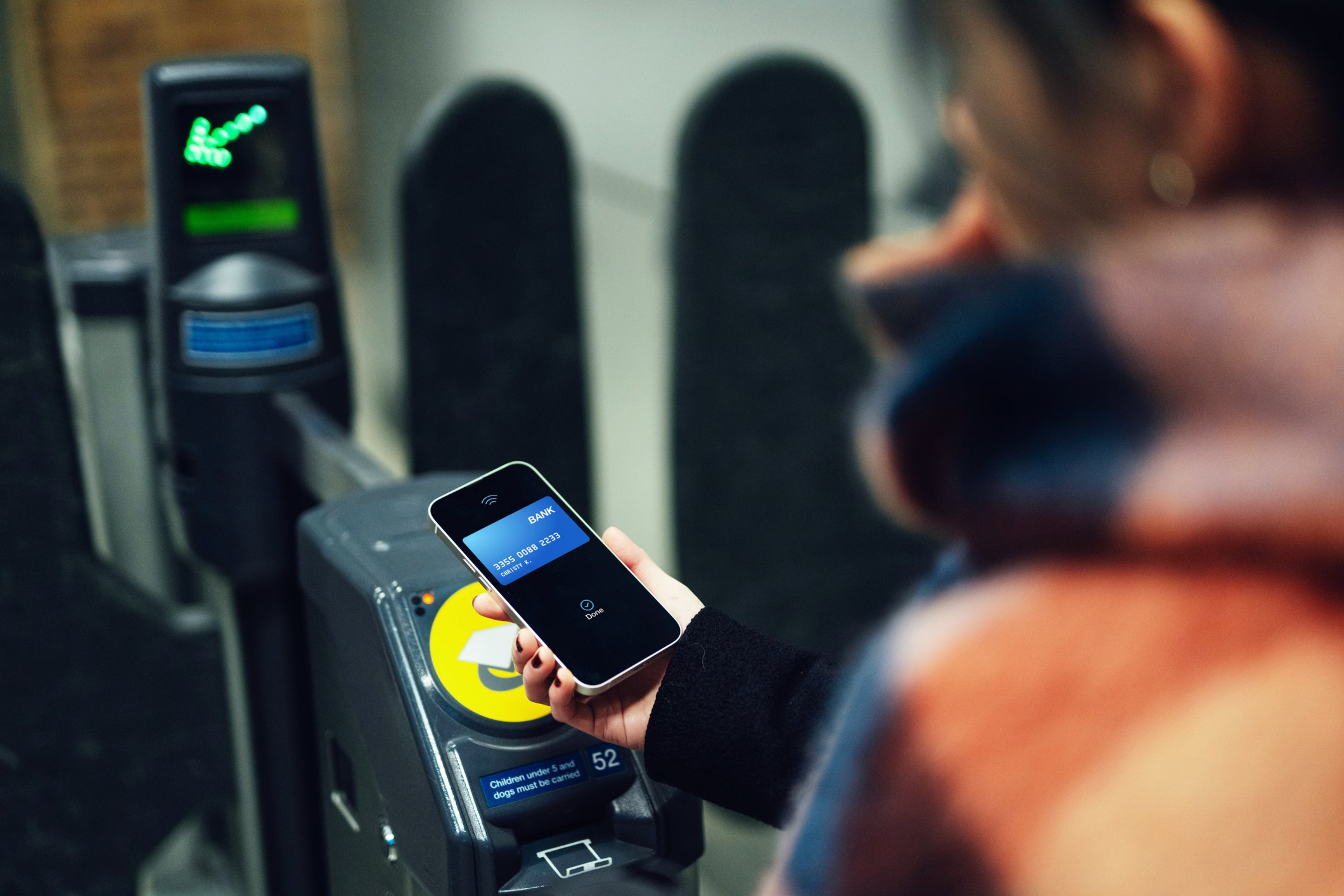
These card readers also work with prepaid Oyster cards sold at all Tube and Overground stations, plus most Elizabeth Line stations and select newsstands and visitor centers throughout London, for 7 British pounds ($8.86) each. If you choose to purchase and pay via an Oyster card, you can add money to the card using the ticket machines found inside Underground stations. You can then purchase daily or weekly travel cards covering various zones.
Regardless of how you pay for your ride, you'll use the same process for confirming your payment. Use your phone (for contactless payments) or debit, credit or Oyster card to tap in and out at the barriers of your start and end stations. Remember that card readers aren't always connected to gates and are sometimes free-standing, so make sure you locate one and tap in and out to avoid getting charged for traveling through all nine zones.
To see the full details and decide exactly which payment method is right for you, check out the Transport for London website .
Daily limits
If you use an Oyster card or contactless payment to pay for your Tube journey, there is a cap on how much you can be charged, depending on the zones you travel in or between.
Say, for example, you only travel within Zones 1 and 2. For a full day of travel via the London Underground in those two zones, you'll pay 8.50 pounds (around $10.76).
You can view the prices for other zones on the TfL website .
Child discounts
All children under the age of 11 can travel on the London Underground for free, and children between 11 and 15 receive discounted fares (as outlined below). To ensure that you get a discount, you should talk to a member of the London Underground staff inside the station.
How much does travel on the London Underground cost?
The London Underground operates a peak and off-peak fare system. The amount you're charged depends on which zones you're traveling in or between.
Peak fares are charged Monday to Friday between the hours of 6:30 and 9:30 a.m. and from 4 to 7 p.m. Off-peak fares are charged at all other times and if you're traveling from a station outside of Zone 1 into Zone 1 between 4 and 7 p.m. on weekdays.
Journeys on the Tube and the Elizabeth Line to and from Heathrow Airport (LHR) are always considered peak fares if you start, end or go through Zone 1.
Travel cards
Peak and off-peak travel cards are also available in the Tube stations' kiosks. The cost of travel cards varies depending on the zones you travel in. Paying with an Oyster card or via contactless payment is usually cheaper.
An Anytime Day travel card can be used for the entire day that you purchase it until 4:30 a.m. the next day.
An Off-peak Day travel card is valid for an entire weekday from 9:30 a.m. — or any time on Saturdays, Sundays and public holidays — until 4:30 a.m. the following day.
How to read the London Tube map
The London Underground map is divided into nine zones. The center of London — along with its most popular tourist attractions and iconic hotels — is in Zone 1. The outer parts of the city are in Zone 9. The zones are serviced by 11 tube lines and a handful of other rail services identified by color.
The London Underground lines are as follows:
- Bakerloo (brown) : From Harrow & Wealdstone in northwest London to Elephant & Castle south of the River Thames
- Central (red) : From West Ruislip in west London to Epping in east London
- Circle (yellow) : From Hammersmith to Edgware Road and then back to Edgware Road in a loop around central London
- District (green) : From Upminster in east London to Richmond in south London
- Hammersmith & City (pink) : From Hammersmith to Barking in east London
- Jubilee (gray) : From Stanmore to Stratford in east London
- Metropolitan (maroon) : From Aldgate to Amersham
- Northern (black) : From Edgware in the northern suburbs to South Wimbledon in southwest London
- Piccadilly (dark blue) : From Cockfosters via Hammersmith to Heathrow Terminals 1, 2, 3, 4 and 5; the Piccadilly Line has two branches, which split at Acton Town
- Victoria (light blue) : From Walthamstow Central in north London through central London to Brixton
- Waterloo & City (turquoise) : From Bank to Waterloo Station
Though not technically Tube lines, you'll also find the following rail routes on the Tube map:
- Overground (orange — double stripe) : From Watford Junction in the northwest to Croydon in the south and from Barking in the east of London to Richmond and Wandsworth in the southwest
- Docklands Light Railway (turquoise — double stripe) : From Bank in the City to Lewisham in east London and Bank to Woolwich Arsenal; there are further routes from Tower Gateway to Beckton, Stratford to Lewisham or Canary Wharf, and Stratford International to Woolwich Arsenal
- Elizabeth Line (purple — double stripe) : From Reading and Heathrow in the west to Shenfield and Abbey Wood in the east
Taking the Tube to Heathrow Airport
Depending on where you're traveling from, the Tube or Elizabeth Line will likely be your cheapest and most direct route to Heathrow Airport.
You can learn more about the best ways to reach Heathrow here .
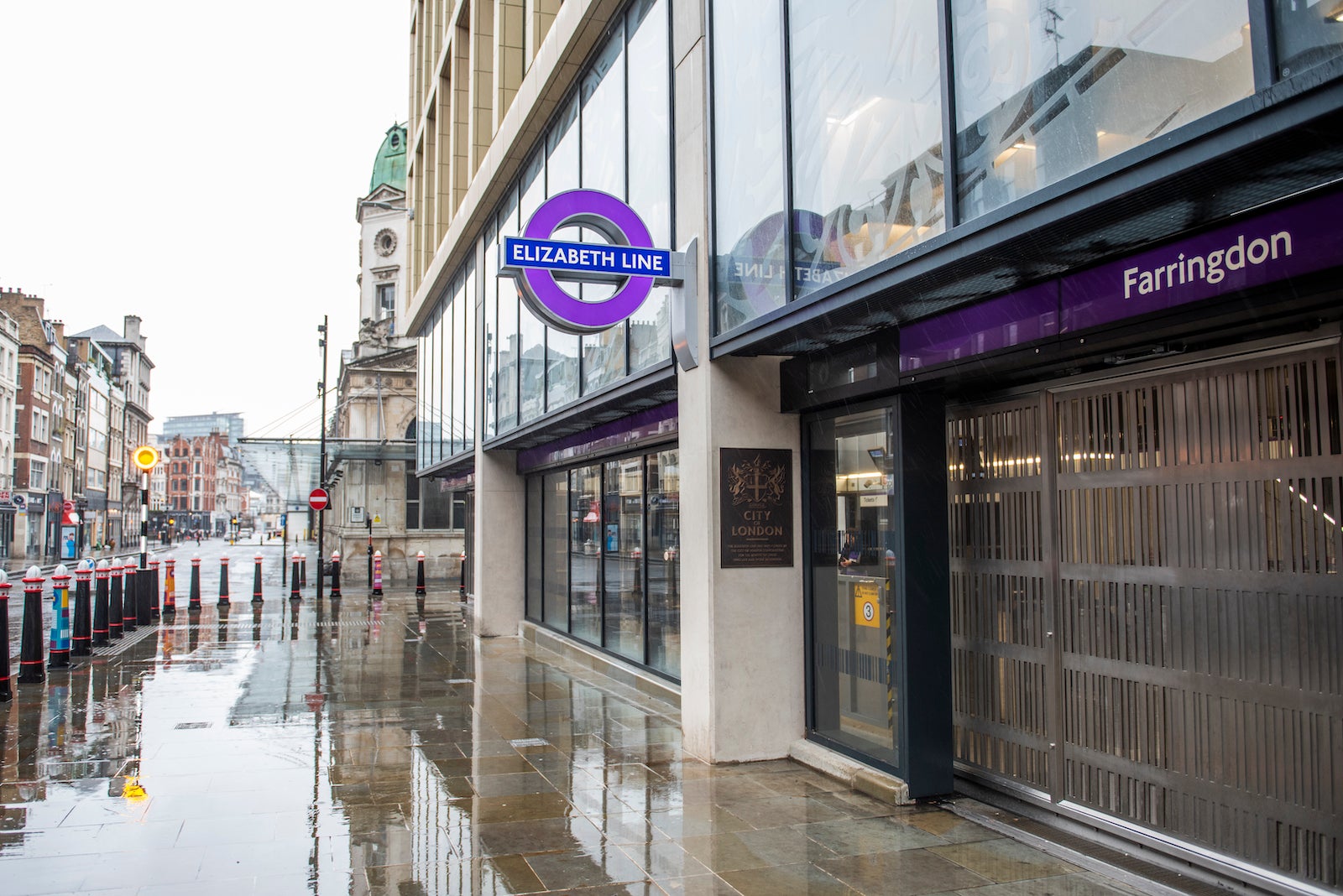
While there's extra space on the Piccadilly Line for suitcases, trains on other lines aren't always as accommodating. Either way, traveling with multiple pieces of luggage at peak times can make for a stressful and awkward journey for you and those around you.
It's not always possible to get to Heathrow without getting on the Tube during peak times. If possible, try to leave earlier to avoid rush hour and have a far more comfortable journey.
How to plan your trip
TfL provides a range of free Tube maps that are available in most Tube stations and some small shops to help you plan your journey.
You can also use TfL's journey planner . Add in your start and end destinations, and the site will work out the nearest Tube stations and what changes you may need to take. The site will also suggest bus routes if they're faster, and it'll advise on journey times.
You can filter its suggestions to only include buses if you wish to avoid the Tube; you can also filter for routes that are accessible, routes near taxi ranks or routes that have the fewest changes or least amount of walking.
In terms of apps, many Londoners tend to use Citymapper ( iOS / Android ) or Google Maps ( iOS / Android ), both of which will provide you with up-to-date Tube suggestions, walking routes and bus options.
How early does the Tube run?
The London Underground's opening times can differ depending on the line you want to take and where you're starting your trip. Generally, though, Tube trains begin operation around 5 a.m. from Monday to Saturday, with slightly reduced operating hours on Sundays.
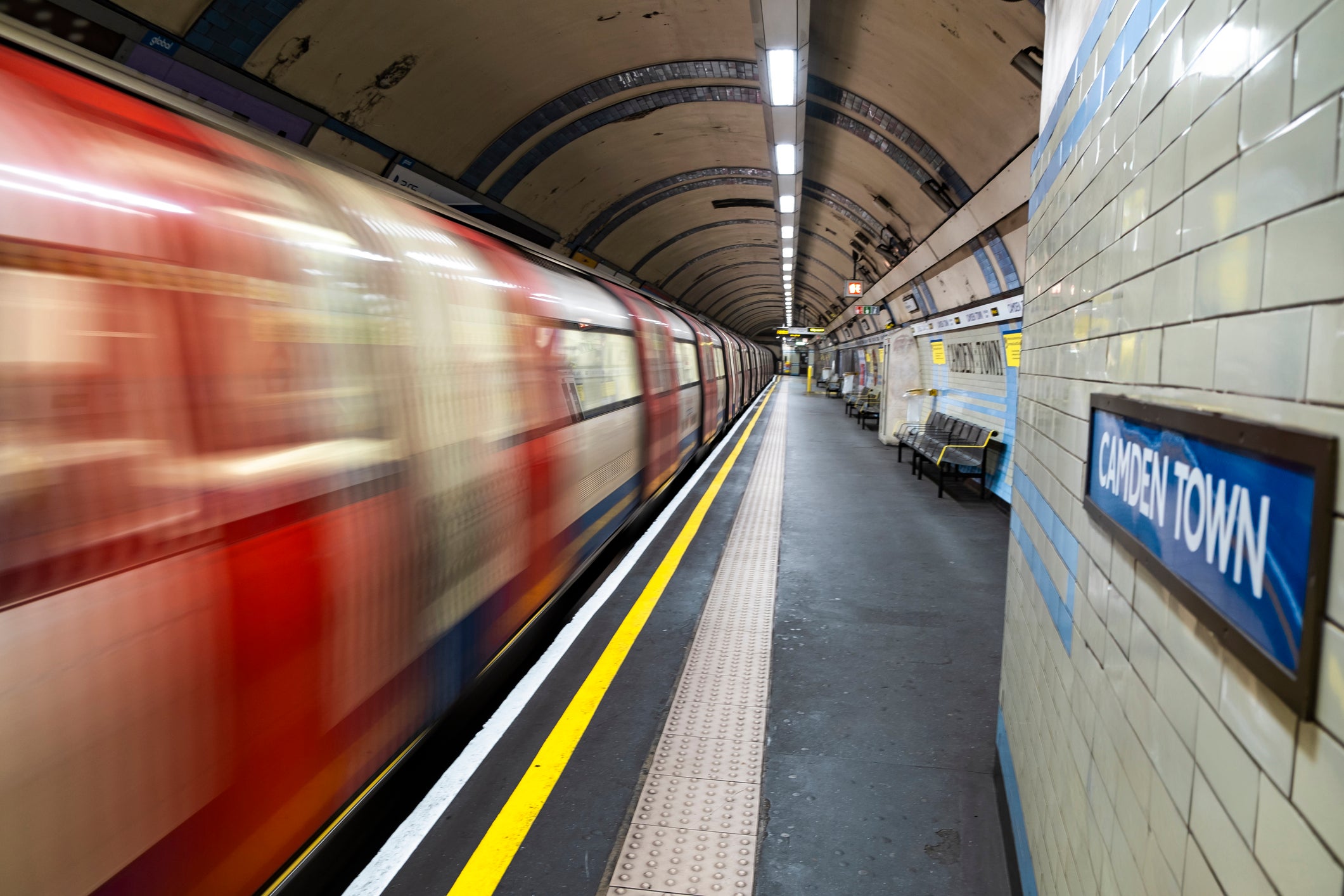
How late does the Night Tube run?
On Friday and Saturday nights, you can ride the Night Tube when the Central, Jubilee, Northern, Piccadilly and Victoria lines run for 24 hours. Additionally, the London Overground operates a 24-hour service on these days between New Cross Gate and Highbury & Islington.
The Night Tube is charged at off-peak rates.
The quickest route might not be the obvious one
If you're not used to London, you might think you need to take the Tube to get anywhere. The Tube is your best bet for longer journeys in and out of the city. However, shorter journeys in central London will likely be quicker on foot.
When planning your journeys, the TfL website has a handy box to help you determine which routes are quicker to walk.
By walking shorter routes, you'll not only save time but will also breathe in less thick, soupy air. The views are guaranteed to be an improvement, too.
Travel etiquette on the London Underground
Polite behavior when traveling on the London Underground can pretty much be simplified into three main rules.
Escalator etiquette
Perhaps the most important rule of Tube stations is to stand on the right on the escalators. This allows those in a rush to glide down the escalators in a flash to avoid waiting an extra minute for the next train.
Mindful Tubing
Everyone getting the Tube has somewhere to be and is likely in a rush. Letting all passengers get off your carriage before boarding will enable a smoother, quicker and more pleasant journey for everyone.
Additionally, don't hog seats if someone in need, such as elderly people, pregnant women or people with disabilities, would benefit more than you by sitting down. Checking if someone needs your seat will go a long way in making someone's journey, if not their entire day, better.
As for rides during busy commuting hours, remember that squishing as tightly as possible into the area closest to the doors doesn't benefit anyone. Move down the train. It makes for a more comfortable, less sweaty journey for everyone.
In general, queueing is somewhat of a national sport for Brits. We do it anywhere and everywhere, and anyone who fails to queue correctly will receive passive-aggressive eye rolls and tuts from all who witness it.
This also applies to the Tube, whether you're waiting to get through the barriers, waiting to get on or waiting for the stairs, escalators or elevators to leave the station. Save yourself the glares and cranky tuts of fellow passengers by falling into line.
Bottom line
Love it or hate it, London would come to a standstill without the Tube. Whether it's your first time in the capital or you're a seasoned Londoner, the above tips will serve you well. Remember, above all else, to stand to the right.

- Places to Visit
- Sightseeing
- Practical Tips
- Where to Stay
How to use the London Underground
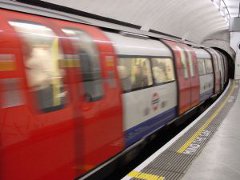
Despite Londoners’ moans, it’s a good service considering it’s the world’s oldest underground system.
There are 12 separate colour-coded lines (including the Docklands Light Railway) that run in northbound, southbound, eastbound or westbound directions.
You’re never far from an underground station in central London – they’re pretty easy to spot.
The new Elizabeth line is actually a train running east to west through central London.
Tube maps and journey planners
View a Tube map or download a PDF version .
Free pocket-sized tube maps are available from underground stations.
The TFL Go app has a ‘live’ tube map, which makes it easy to locate your closest tube station (if location services is turned on), and find the next departure times.
The CityMapper app has a tube map which shows the zones.
Journey planners
If you can’t work out which route to take by looking at the tube map, or if you want door-to-door instruction, see our guide to planning journeys in London .
How to find the right platform
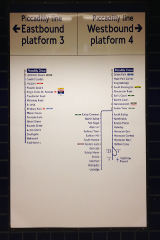
The direction will normally be obvious by looking at the tube map, but if it’s not — here’s what to do:
- Before going through the ticket barriers, or just after the barriers at some stations, look at the destinations list signs to find the tube station you’re travelling to.
- Your destination will be listed on a sign that gives you the direction (eastbound, westbound etc.) at the top.
- Follow the signs and check you’re on the right platform by looking at the destination list on the platform wall.
If you do travel the wrong way, don’t worry, just get off the train and change platform. You won’t pay anything unless you go through the ticket barriers and leave the station.
Some lines have different branches. For example, the westbound Piccadilly line goes to Heathrow, Rayner’s Lane or Uxbridge. Check the display on the platform to make sure you take the right train. You don’t want to end up in Rayner’s Lane if you’re catching a flight from Heathrow.
Tube timetables
The tube does not run to a strict timetable during the day, but you won’t wait long. Most tube trains within central London run every few minutes or so.
If you need more precise information on departure or arrival times, the TfL Journey Planner has a ‘leaving’ or ‘arriving’ option.
Tube first and last times
The first tube trains start running from around 5.00–5.30am. The last tube trains leave central London around 12.30am (see the Night Tube below). Most trains start at least an hour later on Sundays.
The exact start and finish times vary according to each individual underground line. Posters at tube stations give the first and last train times from that station. Alternatively, check the tube timetables on the TfL website for the exact times.
If you need to travel after the tubes have finished, take a bus . Some routes run for 24 hours. If they don’t, there are special night buses.
The Night Tube
There is currently a 24-hour service on Fridays and Saturdays on the following lines:
Some stations on these lines are not served, so check the TfL website before travelling.
The rush hour
There is a morning and evening peak on the underground when the tube trains, tube stations and platforms are extremely busy. The peak times for travel are roughly 7.45am–8.30am and 5.00pm–7.00pm Monday–Friday.
During these busy times you won’t have much room to stand and you definitely won’t find a seat, especially in central London. If you can, wait until after 9.30am before starting your journey.
The TfL Go app tells you if a station is busy or quiet.
Check for delays
You can check if the underground is working normally or if there are any delays on certain lines on the status updates section of the TfL website.
Check for planned engineering work at the weekend
The underground network is being modernised. Engineering work is carried out at weekends and Bank Holidays and sometimes whole sections of the tube are out of action.
When this happens, a replacement bus service run and underground tickets/passes/oyster cards are accepted on the bus. The replacement buses follow the route of the underground line, stopping outside each station, but it might be quicker to travel to your destination by another bus route.
Check TfL’s service update if you travel by tube or the ELizabeth line at the weekend, especially if you plan to travel to or from Heathrow airport.
Related pages
- Guide to London transport tickets and passes
- Underground tickets and Travelcards
- Oyster cards
- Contactles cards
Last updated: 14 February 2023
Getting around London
- How to use the London underground
- How to use London buses
- London cycle hire scheme
- Walking in London
- London trains
- London taxis & minicabs
Useful information
- Plan your journey
- London transport zones
Copyright 2010-2023 toptiplondon.com. All rights reserved. Contact us | Disclaimer | Privacy
Exclusive: Tesla scraps low-cost car plans amid fierce Chinese EV competition
- Medium Text

- Entry-level Tesla car won’t be built, three sources tell Reuters
- Tesla to focus on self-driving taxis instead, sources said
- Strategy shift comes as Tesla faces competition from China EV makers including BYD
‘HALT ALL FURTHER ACTIVITIES’
Running late.
Stay up to date with the latest news, trends and innovations that are driving the global automotive industry with the Reuters Auto File newsletter. Sign up here.
Reporting by Hyunjoo Jin in San Francisco, Norihiko Shirouzu in Austin and Ben Klayman in Detroit. Editing by Marla Dickerson and Brian Thevenot.
Our Standards: The Thomson Reuters Trust Principles. New Tab , opens new tab

Thomson Reuters
Is the Detroit Bureau Chief and North American Transportation Editor, responsible for a team of about 10 reporters covering everything from autos to aerospace to airlines to outer space.
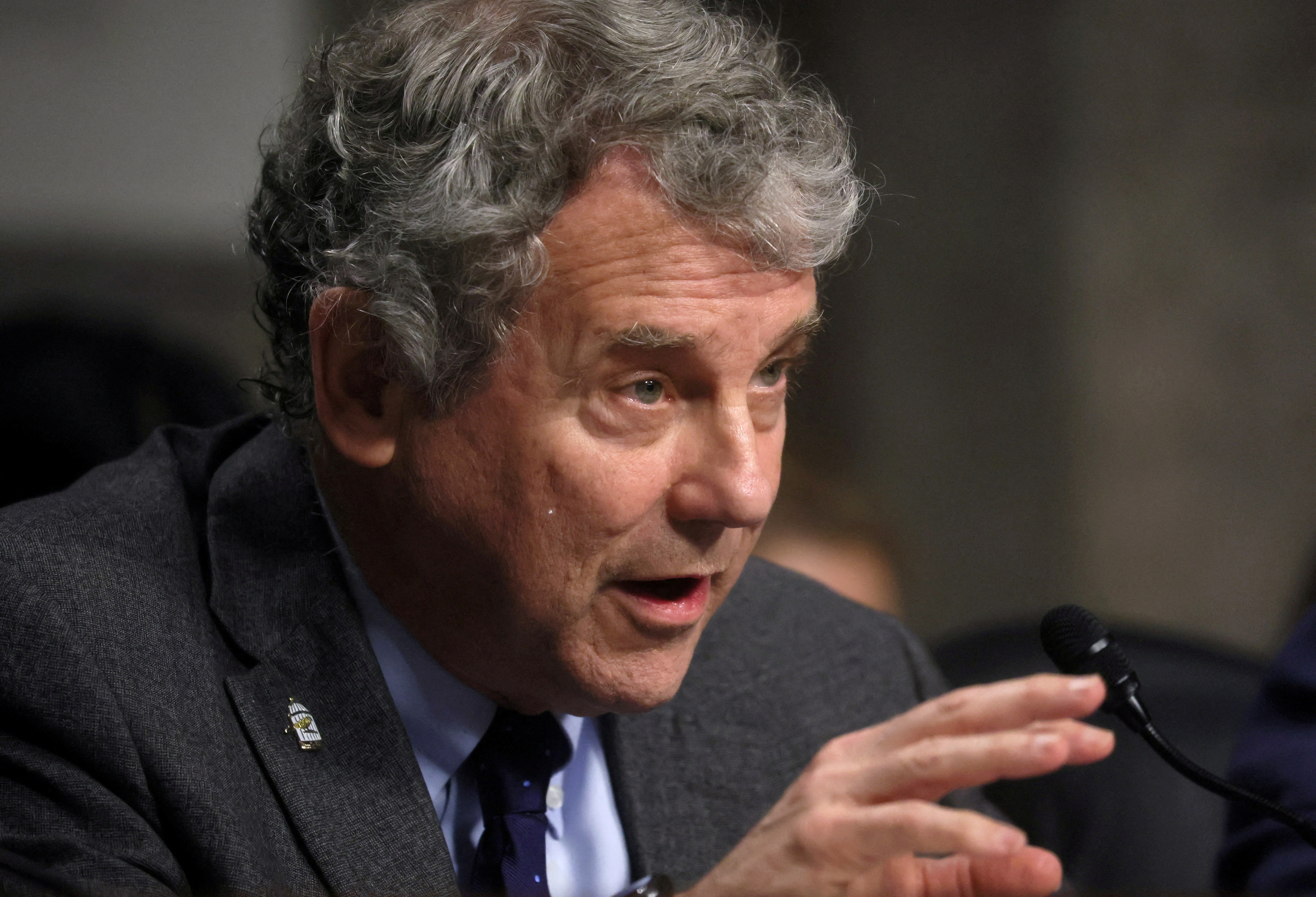
Business Chevron
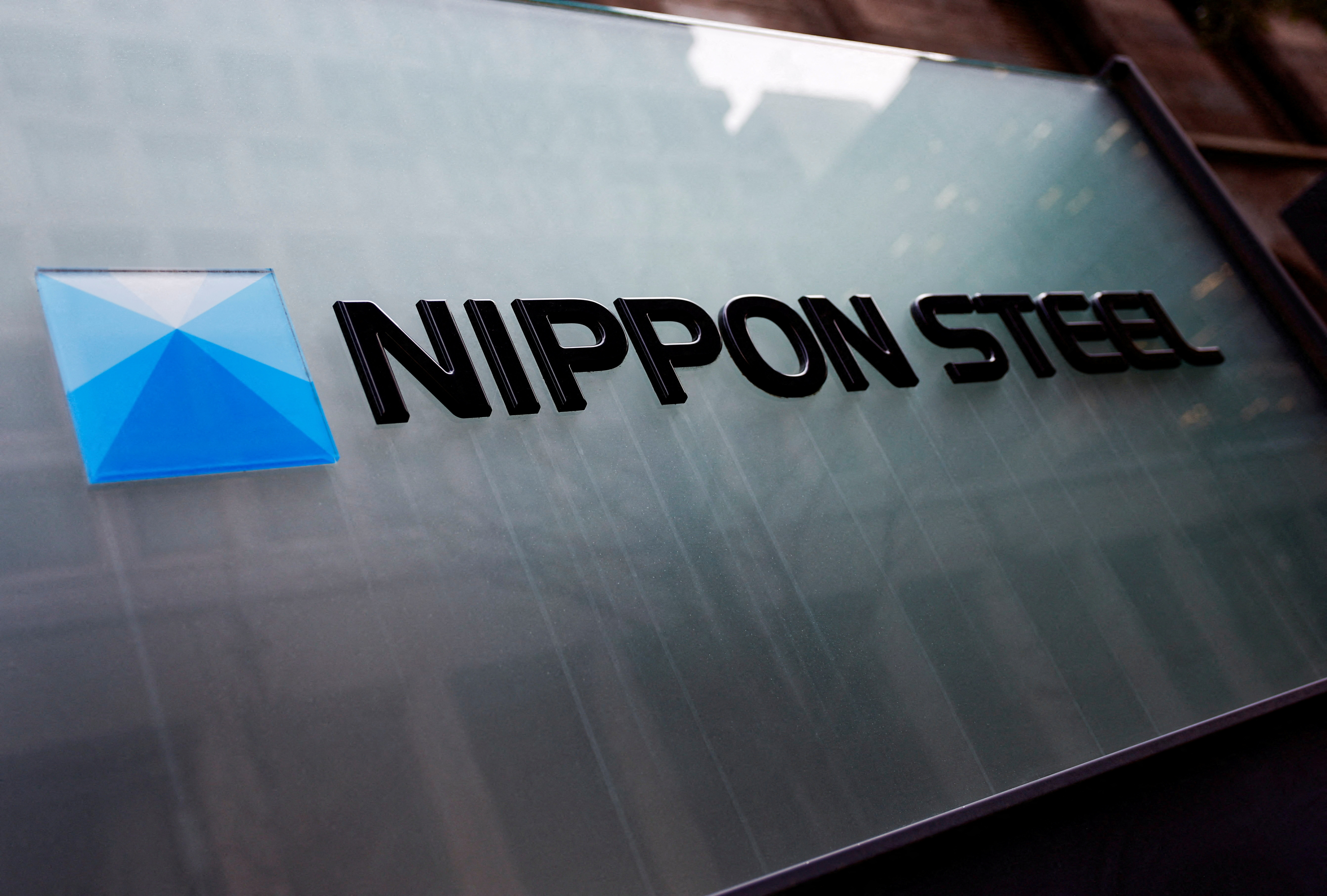
U.S. Steel shareholders approve $14.9 bln buyout by Nippon Steel
U.S. Steel shareholders on Friday approved its proposed $14.9 billion acquisition by Japan's Nippon Steel , as expected, taking the merger one step closer to completion even as political opposition to the deal mounts.

- Share full article
For more audio journalism and storytelling, download New York Times Audio , a new iOS app available for news subscribers.

- April 12, 2024 • 34:23 How One Family Lost $900,000 in a Timeshare Scam
- April 11, 2024 • 28:39 The Staggering Success of Trump’s Trial Delay Tactics
- April 10, 2024 • 22:49 Trump’s Abortion Dilemma
- April 9, 2024 • 30:48 How Tesla Planted the Seeds for Its Own Potential Downfall
- April 8, 2024 • 30:28 The Eclipse Chaser
- April 7, 2024 The Sunday Read: ‘What Deathbed Visions Teach Us About Living’
- April 5, 2024 • 29:11 An Engineering Experiment to Cool the Earth
- April 4, 2024 • 32:37 Israel’s Deadly Airstrike on the World Central Kitchen
- April 3, 2024 • 27:42 The Accidental Tax Cutter in Chief
- April 2, 2024 • 29:32 Kids Are Missing School at an Alarming Rate
- April 1, 2024 • 36:14 Ronna McDaniel, TV News and the Trump Problem
- March 29, 2024 • 48:42 Hamas Took Her, and Still Has Her Husband
How One Family Lost $900,000 in a Timeshare Scam
A mexican drug cartel is targeting seniors and their timeshares..
Hosted by Katrin Bennhold
Produced by Asthaa Chaturvedi and Will Reid
With Clare Toeniskoetter and Lynsea Garrison
Edited by Brendan Klinkenberg and Michael Benoist
Original music by Marion Lozano , Rowan Niemisto , Dan Powell , Pat McCusker and Will Reid
Engineered by Chris Wood
Listen and follow The Daily Apple Podcasts | Spotify | Amazon Music
Warning: this episode contains descriptions of violence.
A massive scam targeting older Americans who own timeshare properties has resulted in hundreds of millions of dollars sent to Mexico.
Maria Abi-Habib, an investigative correspondent for The Times, tells the story of a victim who lost everything, and of the criminal group making the scam calls — Jalisco New Generation, one of Mexico’s most violent cartels.
On today’s episode

Maria Abi-Habib , an investigative correspondent for The New York Times based in Mexico City.

Background reading
How a brutal Mexican drug cartel came to target seniors and their timeshares .
There are a lot of ways to listen to The Daily. Here’s how.
We aim to make transcripts available the next workday after an episode’s publication. You can find them at the top of the page.
The Daily is made by Rachel Quester, Lynsea Garrison, Clare Toeniskoetter, Paige Cowett, Michael Simon Johnson, Brad Fisher, Chris Wood, Jessica Cheung, Stella Tan, Alexandra Leigh Young, Lisa Chow, Eric Krupke, Marc Georges, Luke Vander Ploeg, M.J. Davis Lin, Dan Powell, Sydney Harper, Mike Benoist, Liz O. Baylen, Asthaa Chaturvedi, Rachelle Bonja, Diana Nguyen, Marion Lozano, Corey Schreppel, Rob Szypko, Elisheba Ittoop, Mooj Zadie, Patricia Willens, Rowan Niemisto, Jody Becker, Rikki Novetsky, John Ketchum, Nina Feldman, Will Reid, Carlos Prieto, Ben Calhoun, Susan Lee, Lexie Diao, Mary Wilson, Alex Stern, Dan Farrell, Sophia Lanman, Shannon Lin, Diane Wong, Devon Taylor, Alyssa Moxley, Summer Thomad, Olivia Natt, Daniel Ramirez and Brendan Klinkenberg.
Our theme music is by Jim Brunberg and Ben Landsverk of Wonderly. Special thanks to Sam Dolnick, Paula Szuchman, Lisa Tobin, Larissa Anderson, Julia Simon, Sofia Milan, Mahima Chablani, Elizabeth Davis-Moorer, Jeffrey Miranda, Renan Borelli, Maddy Masiello, Isabella Anderson and Nina Lassam.
Katrin Bennhold is the Berlin bureau chief. A former Nieman fellow at Harvard University, she previously reported from London and Paris, covering a range of topics from the rise of populism to gender. More about Katrin Bennhold
Advertisement

IMAGES
VIDEO
COMMENTS
Single fare finder. Find the cost of a journey between any two stations on Tube, DLR, London Overground, Elizabeth line and National Rail services where pay as you go (contactless or Oyster) is accepted. Fares between two stations may vary depending on the direction of travel, time of day and day of the week. Single fare finder only shows the ...
On Tube, DLR, London Overground, Elizabeth line and National Rail services in London: Peak fares - Monday to Friday (not on public holidays) between 06:30 and 09:30, and between 16:00 and 19:00. Off-peak fares - at all other times and if you travel from a station outside Zone 1 to a station in Zone 1 between 16:00 and 19:00, Monday to Friday.
Overall fare. £0.00. Book train & bus tickets to London. Find fares for tube, rail and bus journeys in London. Calculate Oyster card fare costs on the London Underground, DLR, TfL Rail and National Rail train services.
The transport passes that nearly everyone uses, Oyster and Travelcard, allow you to travel seamlessly across all modes of transport, bus, Underground, train and DLR using the same ticket/pass. Children under 11 travel free on the London Underground and DLR (Docklands Light Railway) at all times. Child fares are available for those under 16 and ...
Rush hour on the London Underground is slightly different to peak time, and runs roughly from 7.30 AM to 9.30 AM, and 5 PM to 7 PM - don't expect to get a seat during rush hour! Peak time is used to work out the fare, and applies from 6.30 AM to 9.30 AM, and 4.30 PM to 7 PM (Mon-Fri). Weekends and public holidays are always classed as off-peak.
Paper ticket or cash ticket: Single tickets cost between £6.70 and £9.80 . Pay-as-you-go (PAYG) or contactless payment methods: By using an Oyster card, which is a prepaid or contactless option, you can save significant money on each journey. For example, if you use it in Zone 1, your ticket will cost less than half the price of a paper ticket.
The fare structure and pricing for London tube tickets depend on the zones traveled and time of travel. The cost of a single ticket can range from £2.40 to £6.00, while a contactless or Oyster card can offer reduced fares for frequent travelers. The travel card and visitor Oyster card offer unlimited travel for a day or week, which is ...
Transport for London's online Journey Planner shows the quickest way from A to B. It's possible to choose bus/tube/train only routes. It also gives you the Pay as you go Oyster peak/contactless and off-peak fares. Do bear in mind that the default is the quickest route, which is not always the cheapest. For example, to Heathrow Airport:
The app is built around our iconic Tube map. To get started: • Touch the map or search to plan your journey. • See the status of all lines. • Re-route as you travel - we'll suggest alternatives. • Switch to the step-free map for accessible journeys. • Find out when your next train, bus or tram is due. • Look up which platform your ...
Tube Map is the award-winning navigation app that includes the official TfL (Transport for London) Tube Map. ... Use step-by-step directions in the journey planner to find your way around London. ... at the cost of your chosen price tier. Subscriptions can be managed and auto-renewal may be turned off by going to Account Settings in your ...
Central London is covered by Zone 1. The Tube network has 11 lines. The Tube fare depends on how far you travel, the time of day, and what type of ticket or payment method you use. Oyster cards or contactless payments are the cheapest ways to pay for Tube journeys. Tube services usually run from 5am until midnight, with Night Tube services on ...
The app is built around our iconic Tube map. To get started: • Touch the map or search to plan your journey. • See the status of all lines. • Check how busy each London Underground station is right now. • Re-route as you travel - we'll suggest alternatives. • Switch to the step-free map for accessible journeys.
If you use an Oyster card or contactless payment to pay for your Tube journey, there is a cap on how much you can be charged, depending on the zones you travel in or between. Say, for example, you only travel within Zones 1 and 2. For a full day of travel via the London Underground in those two zones, you'll pay 8.50 pounds (around $10.76).
Get in touch via the TfL Go app through the 'Report an issue' link or in the Settings area. Or call 0343 222 1234 ( Charges may apply) or textphone 0800 112 3456. We'll share our open data with other transport apps that you might already be using. Plan your London journey safely and securely. See maps and live times for London Underground ...
The first tube trains start running from around 5.00-5.30am. The last tube trains leave central London around 12.30am (see the Night Tube below). Most trains start at least an hour later on Sundays. The exact start and finish times vary according to each individual underground line. Posters at tube stations give the first and last train times ...
Plan a rail journey in the UK or Europe with our Journey Planner. Our Journey Planner will show you all the available options to get you from A to B. Enter your departure and arrival stations and our clever tool will show you all the relevant info, including: Train times. Direct and indirect services. Changes.
The cost of a tube ride in London for a single journey in zone 1 is £5.50-£8.70. On the contrary, the same tube ride fare with an Oyster or contactless card will cost you £2.40. Go for the one you think is the best deal for you and experience a hassle-free journey. Answered by Rydeu.
Travel information for all London Tube lines: maps, timetables and fares. Skip to navigation Skip to content Skip to footer ... Our live map tool and route finder helps you plan travel on the move. Contact us. Open: Monday to Friday: 08:00-20:00 Closed: Weekends and bank holidays. ... Journeys Plan a journey and favourite it for quick access in ...
His first "master plan" New Tab , opens new tab for the company in 2006 called for manufacturing luxury models first, then using the profits to finance a "low cost family car."
Warning: this episode contains descriptions of violence. A massive scam targeting older Americans who own timeshare properties has resulted in hundreds of millions of dollars sent to Mexico.
Get started on your journey with TfL Go. Use our live map to see your route - or search any place or address across London. Get live bus, train and tram times and the quieter times to travel. Get live updates on all bus, Tube, London Overground, DLR, Elizabeth line and tram lines. Check walking and cycling routes for all or part of your journey.